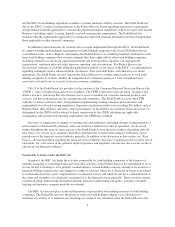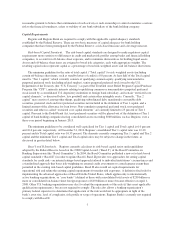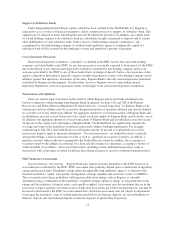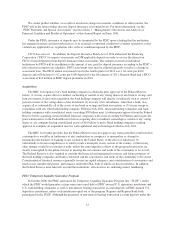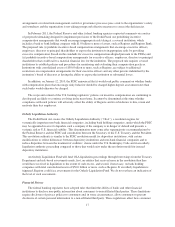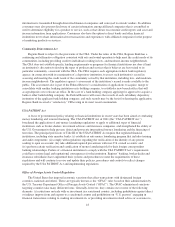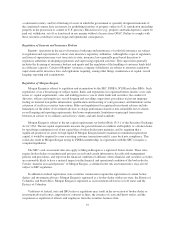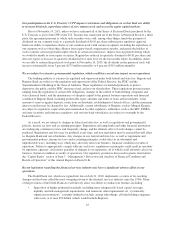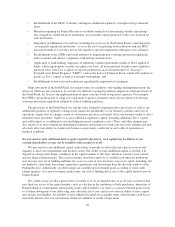Regions Bank 2010 Annual Report Download - page 30
Download and view the complete annual report
Please find page 30 of the 2010 Regions Bank annual report below. You can navigate through the pages in the report by either clicking on the pages listed below, or by using the keyword search tool below to find specific information within the annual report.TLGP ended on June 30, 2010, the Dodd-Frank Act provides for unlimited FDIC deposit insurance coverage on
non-interest bearing transaction accounts at all insured institutions, regardless of participation in the TLGP, until
January 1, 2013.
On December 11, 2008, Regions Bank issued and sold $3.5 billion aggregate principal amount of its senior
bank notes guaranteed under the TLGP. Regions Bank issued and sold an additional $250 million aggregate
principal amount of FDIC-guaranteed senior bank notes on December 16, 2008. Under the TLGP, the FDIC will
pay the unpaid principal and interest on such FDIC-guaranteed debt instruments upon the uncured failure of
Regions Bank to make a timely payment of principal or interest. Neither Regions nor Regions Bank is permitted
to use the proceeds from the sale of securities guaranteed under the TLGP to prepay any of its other debt that is
not guaranteed by the FDIC.
U.S. Treasury Capital Purchase Program
Pursuant to the CPP, on November 14, 2008, Regions issued and sold to the U.S. Treasury in a private
offering, (i) 3.5 million shares of Series A Preferred Stock and (ii) a warrant (the “Warrant”) to purchase
48,253,677 shares of Regions’ common stock, at an exercise price of $10.88 per share, subject to certain anti-
dilution and other adjustments, for an aggregate purchase price of $3.5 billion in cash. The securities purchase
agreement, dated November 14, 2008, pursuant to which the securities issued to the U.S. Treasury under the CPP
were sold, limits the payment of dividends on Regions’ common stock to $0.10 per share without prior approval
of the U.S. Treasury, limits Regions’ ability to repurchase shares of its common stock (with certain exceptions,
including the repurchase of our common stock to offset share dilution from equity-based compensation awards),
grants the holders of the Series A Preferred Stock, the Warrant and the common stock of Regions to be issued
under the Warrant certain registration rights in order to facilitate resale, and subjects Regions to certain of the
executive compensation limitations included in the Emergency Economic Stabilization Act of 2008 (“EESA”), as
amended by the American Recovery and Reinvestment Act of 2009 (“ARRA”).
Depositor Preference
Under federal law, depositors and certain claims for administrative expenses and employee compensation
against an insured depository institution would be afforded a priority over other general unsecured claims against
such an institution in the “liquidation or other resolution” of such an institution by any receiver.
Incentive Compensation
Guidelines adopted by the federal banking agencies pursuant to the FDIA prohibit excessive compensation
as an unsafe and unsound practice and describe compensation as excessive when the amounts paid are
unreasonable or disproportionate to the services performed by an executive officer, employee, director or
principal stockholder.
In June 2010, the Federal Reserve issued comprehensive guidance on incentive compensation policies (the
“Incentive Compensation Guidance”) intended to ensure that the incentive compensation policies of banking
organizations do not undermine the safety and soundness of such organizations by encouraging excessive risk-
taking. The Incentive Compensation Guidance, which covers all employees that have the ability to materially
affect the risk profile of an organization, either individually or as part of a group, is based upon the key principles
that a banking organization’s incentive compensation arrangements should (i) provide incentives that do not
encourage risk-taking beyond the organization’s ability to effectively identify and manage risks, (ii) be
compatible with effective internal controls and risk management, and (iii) be supported by strong corporate
governance, including active and effective oversight by the organization’s board of directors. Any deficiencies in
compensation practices that are identified may be incorporated into the organization’s supervisory ratings, which
can affect its ability to make acquisitions or perform other actions. The Incentive Compensation Guidance
provides that enforcement actions may be taken against a banking organization if its incentive compensation
16


